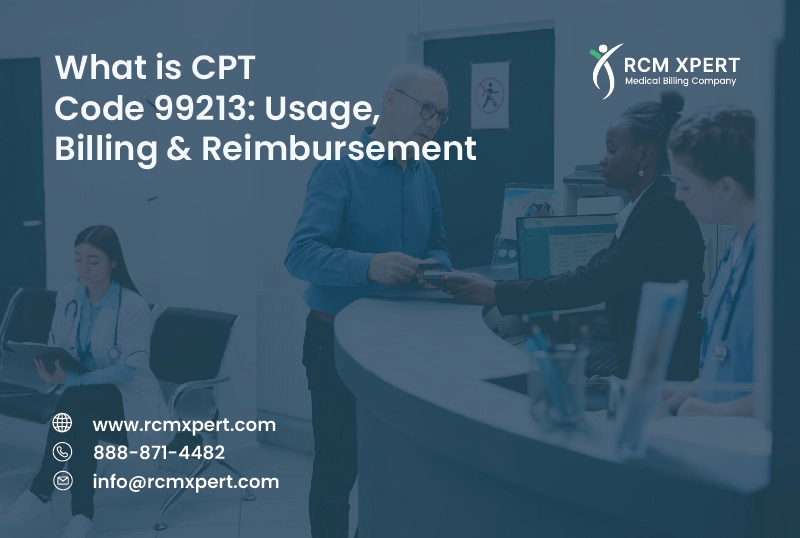CPT Code 99213 is more than just a sequence of numbers in the medical billing world; it’s a gateway to ensuring proper reimbursement for the essential evaluation and management services provided to established patients in healthcare practices.
This code represents the crux of patient care, encapsulating the intricate balance between time, expertise, and documentation required for a 15-minute encounter. As healthcare providers, understanding the 99213 CPT Code is not only pivotal for accurate billing but also crucial for optimizing revenue streams while delivering quality care.
Whether you’re in a bustling private practice or a specialized outpatient clinic, mastering the intricacies of this code is akin to unlocking the financial backbone of your services.
Overview of CPT Code 99213
CPT Code 99213 is a fundamental component of medical billing, denoting a specific set of evaluation and management services provided to established patients during office or outpatient visits.
This code signifies moderate-level encounters, typically involving a comprehensive assessment of the patient’s condition, treatment plan adjustments, and necessary interventions within a 15-minute timeframe.
Understanding when to utilize CPT Code 99213 is crucial for healthcare providers to accurately capture the complexity of patient encounters and ensure proper reimbursement for their services.
A brief explanation of CPT code 99213: This code represents the provision of evaluation and management services for established patients in outpatient settings, specifically targeting moderate-level encounters.
When to use CPT code 99213: CPT Code 99213 is employed when a patient’s visit requires a moderate level of medical decision-making and complexity, typically involving the evaluation and management of common or stable health issues.
This includes but is not limited to routine follow-up appointments, management of chronic conditions, and addressing acute illnesses or injuries that do not necessitate extensive workup or intervention.
Criteria for Assigning CPT Code 99213
When assigning CPT Code 99213, several specific criteria must be met to ensure accurate billing and reimbursement. Firstly, the encounter must involve the evaluation and management of an established patient in an office or outpatient setting.
The complexity of the visit should necessitate a medically appropriate history and/or examination, along with a low level of medical decision-making. Additionally, when time is utilized for code selection, the total time spent during the encounter should fall within the range of 20-29 minutes.
It’s essential to emphasize the significance of thorough and accurate documentation to support the assignment of CPT Code 99213, ensuring compliance with coding guidelines and facilitating proper reimbursement. Here are the key criteria for assigning CPT Code 99213 in bullet points:
- Evaluation and management of an established patient in an office or outpatient setting.
- Medically appropriate history and/or examination.
- Low level of medical decision-making.
- Total encounter time ranges from 20-to 29 minutes.
- Importance of accurate documentation to support code assignment and ensure compliance.
How is CPT Code 99213 Used in Medical Billing?
CPT Code 99213 plays a crucial role in medical billing, specifically for moderate-level outpatient office visits where established patients receive evaluation and management services.
Accurate documentation is paramount in ensuring proper reimbursement under this code, highlighting the complexity of the encounter and the medical decision-making involved.
Here are the key aspects of how CPT Code 99213 is used in medical billing:
Billing for Moderate-Level Outpatient Visits:
CPT Code 99213 is utilized to bill for evaluation and management services provided during moderate-level outpatient office visits. This includes assessing established patients’ conditions, adjusting treatment plans, and addressing their healthcare needs within a 15-minute encounter.
Documentation for Reimbursement:
Accurate documentation is essential for proper reimbursement under CPT Code 99213. It should reflect the complexity of the patient encounter, including the history obtained, examination performed, and medical decision-making involved. Detailed documentation ensures that the services rendered are appropriately coded and billed, aligning with coding guidelines and payer requirements.
CPT Code 99213 VS 99214
When comparing CPT Code 99213 to 99214, it’s essential to understand the differences in complexity and documentation requirements. While both codes are used for evaluation and management services, 99213 typically represents a lower level of complexity compared to 99214. The decision to use one code over the other depends on factors such as the intensity of the patient encounter and the level of medical decision-making involved.
CPT Code 99213 VS 99214
| Aspect | CPT Code 99213 | CPT Code 99214 |
| Evaluation Level | Moderate | Moderate to High |
| Documentation | Requires medically appropriate history and/or examination, low level of medical decision-making | Requires comprehensive history and/or examination, moderate level of medical decision-making |
| Encounter Time | Typically 15 minutes | Typically 25 minutes |
| Examples | Follow-up visits, minor illnessesor injuries | Complex follow-up visits, managingmultiple chronic conditions |
Documentation Guidelines
Comprehensive documentation not only reflects the complexity of the patient encounter but also supports the medical necessity of the services rendered. Healthcare providers must adhere to specific documentation guidelines to appropriately assign CPT Code 99213 and avoid coding errors.
Patient History: Document a thorough patient history, including chief complaint, present illness, past medical history, family history, and review of systems.
Physical Examination: Conduct a comprehensive physical examination and document pertinent findings related to the patient’s chief complaint and medical condition.
Medical Decision Making: Clearly outline the medical decision-making process, including assessment and plan, diagnostic tests ordered or reviewed, and treatment options considered.
Time Spent: When time is used for code selection, document the total time spent on the date of the encounter, ensuring it falls within the appropriate range for CPT Code 99213 (typically 20-29 minutes).
Modifiers: Apply any necessary modifiers to indicate unique circumstances or additional services provided during the encounter, such as prolonged services or shared/split visits.
Templates and EHRs: Utilize templates and electronic health records (EHRs) effectively to streamline documentation processes while ensuring accuracy and completeness.
Clarity and Specificity: Ensure documentation is clear, concise, and specific to accurately reflect the complexity of the patient encounter and support the assigned CPT code.
Conclusion
Understanding CPT Code 99213 is crucial for healthcare providers in medical billing and documentation. This code serves as a cornerstone in accurately capturing the complexity of patient encounters during moderate-level outpatient visits. By adhering to documentation guidelines and coding principles, providers can ensure compliance, optimize reimbursement, and ultimately enhance the quality of care delivered to established patients.
Through ongoing education and awareness, healthcare professionals can continue to refine their understanding of CPT Code 99213, empowering them to navigate the evolving healthcare landscape with confidence and precision.














